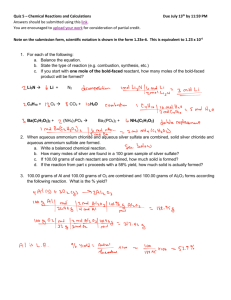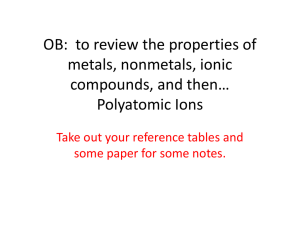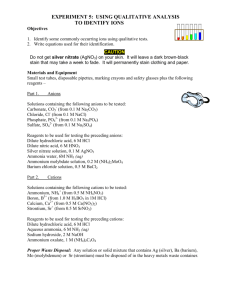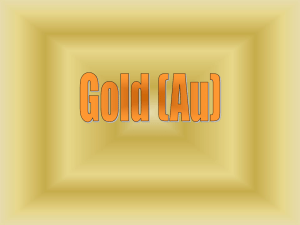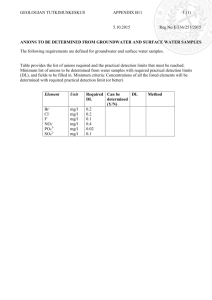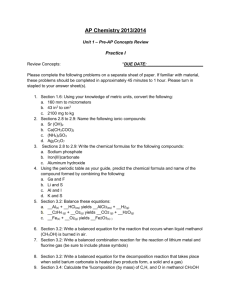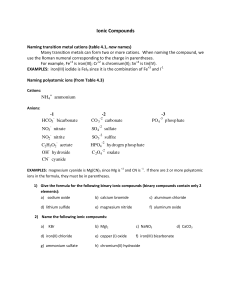Chemical Formula Writing Worksheet
advertisement
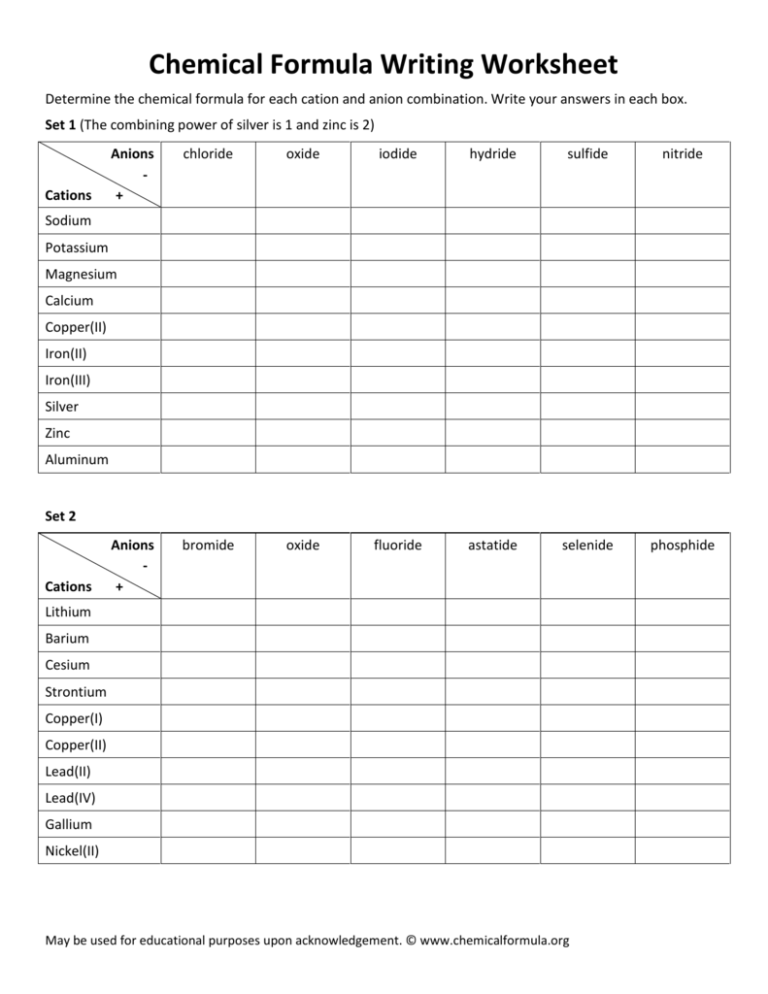
Chemical Formula Writing Worksheet Determine the chemical formula for each cation and anion combination. Write your answers in each box. Set 1 (The combining power of silver is 1 and zinc is 2) Cations Anions + chloride oxide iodide hydride sulfide nitride bromide oxide fluoride astatide selenide phosphide Sodium Potassium Magnesium Calcium Copper(II) Iron(II) Iron(III) Silver Zinc Aluminum Set 2 Cations Anions + Lithium Barium Cesium Strontium Copper(I) Copper(II) Lead(II) Lead(IV) Gallium Nickel(II) May be used for educational purposes upon acknowledgement. © www.chemicalformula.org Chemical Formula Writing Worksheet Determine the chemical formula for each cation and anion combination. Write your answers in each box. Brackets are only needed when the polyatomic group is greater than 1. Eg. Strontium phosphate, Sr3(PO4)2 Set 3 (The combining power of silver is 1 and zinc is 2. The formula for the ammonium ion is NH4+) Cations Anions + nitrate NO3- sulfate SO42- hydroxide OH- carbonate CO32- phosphate PO43- hydrogen carbonate HCO3- Sodium Potassium Magnesium Barium Iron(II) Iron(III) Silver Zinc Aluminum Ammonium Set 4 (The combining power of silver is 1 and zinc is 2. The formula for the ammonium ion is NH4+) Cations Anions + nitrite NO2- chromate CrO42- sulfite, SO32- dichromate Cr2O72- chlorate ClO3- acetate* CH3COO- Lithium Mercury(I) Tin(II) Silver Iron(II) Iron(III) Barium Zinc Aluminum Ammonium *The acetate group, CH3COO- is written first as this correctly shows the position of the ionic bond. Eg. CH3COO-Na+ May be used for educational purposes upon acknowledgement. © www.chemicalformula.org Chemical Formula Writing Worksheet - Answers Set 1 (The combining power of silver is 1 and zinc is 2) Cations Anions + Sodium Na+ NaCl Na2O NaI NaH Na2S Na3N Potassium K+ KCl K2O KI KH K2S K3N MgCl2 MgO MgI2 MgH2 MgS Mg3N2 Magnesium Mg2+ chloride Cl- oxide O2- iodide I- hydride H- sulfide S2- nitride N3- Calcium Ca2+ CaCl2 CaO CaI2 CaH2 CaS Ca3N2 Copper(II) Cu2+ CuCl2 CuO CuI2 CuH2 CuS Cu3N2 Iron(II) Fe2+ FeCl2 FeO FeI2 FeH2 FeS Fe3N2 Iron(III) Fe3+ FeCl3 Fe2O3 FeI3 FeH3 Fe2S3 FeN Silver Ag+ AgCl Ag2O AgI AgH Ag2S Ag3N Zinc Zn2+ ZnCl2 ZnO ZnI2 ZnH2 ZnS Zn3N2 Aluminum Al3+ AlCl3 Al2O3 AlI3 AlH3 Al2S3 AlN Set 2 Cations Anions + bromide Br- oxide O2- fluoride F- astatide At- selenide Se2- phosphide P3- Lithium Li+ LiBr Li2O LiF LiAt Li2Se Li3P Barium Ba2+ BaBr2 BaO BaF2 BaAt2 BaSe Ba3P2 Cesium Cs+ CsBr Cs2O CsF CsAt Cs2Se Cs3P Strontium Sr2+ SrBr2 SrO SrF2 SrAt2 SrSe Sr3P2 Copper(I) Cu+ CuBr Cu2O CuF CuAt Cu2Se Cu3P Copper(II) Cu2+ CuBr2 CuO CuF2 CuAt2 CuSe Cu3P2 Lead(II) Pb2+ PbBr2 Pb2O3 PbF3 PbAt2 PbSe Pb3P2 Lead(IV) Pb4+ PbBr4 Pb2O PbF4 PbAt4 PbSe2 Pb3P4 Gallium Ga3+ GaBr3 Ga2O3 GaF3 GaAt3 Ga2Se3 GaP Nickel(II) Ni2+ NiBr2 NiO NiF2 NiAt2 NiSe Ni3P2 May be used for educational purposes upon acknowledgement. © www.chemicalformula.org Chemical Formula Writing Worksheet - Answers Brackets are only needed when the polyatomic group is greater than 1. Eg. Strontium phosphate, Sr3(PO4)2 Set 3 (The combining power of silver is 1 and zinc is 2. The formula for the ammonium ion is NH4+) Cations Anions + Sodium Na+ LiNO3 Li2SO4 LiOH Li2CO3 Li3PO4 LiHCO3 Potassium K+ KNO3 K2SO4 KOH K2CO3 K3PO4 KHCO3 Mg(NO3)2 MgSO4 Mg(OH)2 MgCO3 Mg3(PO4)2 Mg(HCO3)2 Magnesium Mg2+ nitrate NO3- sulfate SO42- hydroxide OH- carbonate CO32- phosphate PO43- hydrogen carbonate HCO3- Barium Ba2+ Ba(NO3)2 BaSO4 Ba(OH)2 BaCO3 Ba3(PO4)2 Ba(HCO3)2 Iron(II) Fe2+ Fe(NO3)2 FeSO4 Fe(OH)2 FeCO3 Fe3(PO4)2 Fe(HCO3)2 Iron(III) Fe3+ Fe(NO3)3 Fe2(SO4)3 Fe(OH)3 Fe2(CO3)3 FePO4 Fe(HCO3)3 Silver Ag+ AgNO3 Ag2SO4 AgOH Ag2CO3 Ag3PO4 AgHCO3 Zinc Zn2+ Zn(NO3)3 ZnSO4 Zn(OH)2 ZnCO3 Zn3(PO4)2 Zn(HCO3)2 Aluminum Al3+ Al(NO3)3 Al2(SO4)3 Al(OH)3 Al2(CO3)3 AlPO4 Al(HCO3)3 NH4NO3 (NH4)2SO4 NH4OH (NH4)2CO3 (NH4)3PO4 NH4HCO3 Ammonium NH4+ Set 4 (The combining power of silver is 1 and zinc is 2. The formula for the ammonium ion is NH4+) Cations Anions + Lithium Li+ LiNO2 Li2CrO4 Li2SO3 Li2Cr2O7 LiClO3 CH3COOLi Mercury(I) Hg+ HgNO2 Hg2CrO4 Hg2SO3 Hg2Cr2O7 HgClO3 CH3COOHg Tin(II) Sn2+ Sn(NO2)2 SnCrO4 Sn(SO3)2 SnCr2O7 Sn(ClO3)2 (CH3COO)2Sn Silver Ag+ AgNO2 Ag2CrO4 AgSO3 Ag2Cr2O7 AgClO3 CH3COOAg Iron(II) Fe2+ Fe(NO2)2 FeCrO4 Fe(SO3)2 FeCr2O7 Fe(ClO3)2 (CH3COO)2 Fe Iron(III) Fe3+ Fe(NO2)3 Fe2(CrO4)3 Fe2(SO3)3 Fe2(Cr2O7)3 Fe(ClO3)3 (CH3COO)3 Fe Barium Ba2+ Ba(NO2)2 BaCrO4 Ba(SO3)2 BaCr2O7 Ba(ClO3)2 (CH3COO)2 Ba Zinc Zn2+ Zn(NO2)2 ZnCrO4 Zn(SO3)2 ZnCr2O7 Zn(ClO3)2 (CH3COO)2 Zn Aluminum Al3+ Al(NO2)3 Al2(CrO4)3 Al2(SO3)3 Al2(Cr2O7)3 Al(ClO3)3 (CH3COO)3 Al NH4NO2 (NH4)2CrO4 NH4SO3 (NH4)2Cr2O7 NH4ClO3 CH3COONH4 Ammonium NH4+ nitrite NO2- chromate CrO42- sulfite, SO32- dichromate Cr2O72- chlorate ClO3- acetate* CH3COO- *The acetate group, CH3COO- is written first as this correctly shows the position of the ionic bond. Eg. CH3COO-Na+ May be used for educational purposes upon acknowledgement. © www.chemicalformula.org
